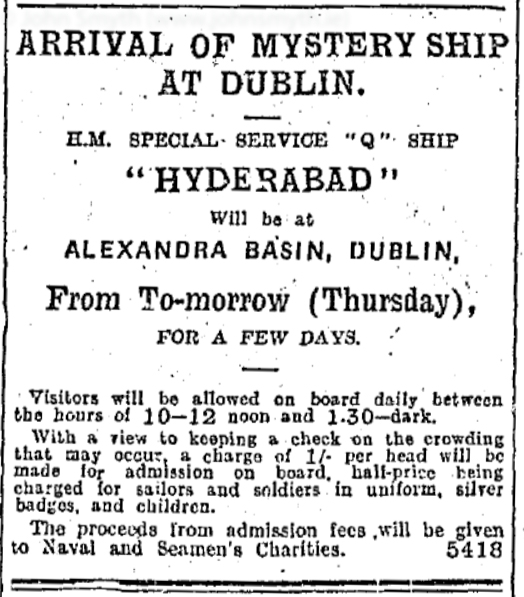Submarine warfare was one of the many grim innovations of the First World War. Britain used it’s large naval fleet to blockade Germany, and in retaliation, Germany’s U-boat fleet declared any ship sailing to Britain as a legitimate target, irrespective of nationality. By early1915, German U-boats were waging unrestricted war against Allied shipping, leading to very significant losses. Usable sonar technology didn’t exist, so submerged submarines were almost impossible to detect. However, submarines in WWI had a limited number of torpedoes, and frequently surfaced to attack cargo ships using a deck gun.
Surface warships were well capable of destroying submarines that had surfaced, but the trick was finding them. One idea was the use of Q-ships. A Q-ship was a ship that looked like a defenceless freighter or cargo vessel, but carried deck guns that were kept hidden until a submarine surfaced to attack it. The Q designation was in reference to their home port during the war – Cobh in Cork (then called Queenstown). Other navies, including the German one, had their own versions of Q-ships, but the Royal Navy had around around 200 ships. The British Q-ships sunk 14 U-boats and damaged around 60 more, but at a loss of nearly thirty Q-ships. The risk of offering the ship as bait for a submarine attack was obvious, and success relied on the Q-ship’s disguise fooling the u-boat crew – so that the Q-ship crew had enough time to deploy the deck gun and score a direct hit on the submarine faster than it could fire back.
During the war, most of the Q-ships were conversions (from steamships or schooners), but in 1917, the first ship commissioned and designed as a Q-ship was launched. It was HMS Hyderabad and, along with a visible deck gun, carried two bigger hidden ones. It was also fitted with torpedo tubes. It never saw action which is probably just as well, becuase there wasn’t much attempts to hide its purpose once the war ended. This day 100 years ago, a guided tour of the ship ,open to all, was advertised in the Irish Independent , as was the true purpose of the ship.
